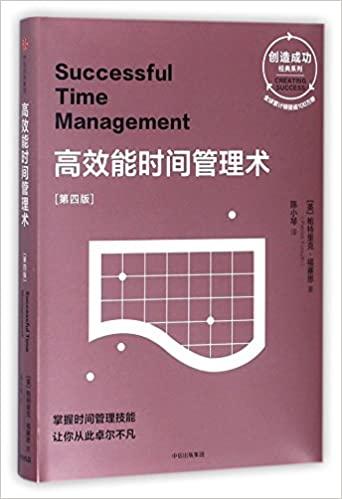Question
1. Which of the following is a primary objective of operations management? a) Maximizing revenue b) Minimizing costs c) Maximizing employee satisfaction d) Maximizing marketing
1. Which of the following is a primary objective of operations management? a) Maximizing revenue b) Minimizing costs c) Maximizing employee satisfaction d) Maximizing marketing efforts
2. What is the primary goal of capacity planning in operations management? a) Minimizing production b) Maximizing overtime c) Matching production with demand d) Reducing workforce
3. Which production process focuses on producing a high volume of standardized products with low unit costs? a) Job shop b) Batch production c) Mass production d) Custom production
4. Just-in-Time (JIT) is an inventory management approach that aims to: a) Maximize inventory levels b) Minimize production speed c) Eliminate waste and minimize inventory d) Increase lead times
5. Total Quality Management (TQM) is a strategy that emphasizes: a) Maximizing profits at any cost b) Reducing employee involvement c) Continuous improvement and customer satisfaction d) Minimizing product quality
6. The 5S methodology is a tool often used for: a) Project management b) Inventory control c) Workplace organization and cleanliness d) Cost estimation
7. What is the primary purpose of a Gantt chart in operations management? a) Resource allocation b) Inventory management c) Project scheduling d) Quality control
8. Which of the following is a key performance indicator (KPI) used in operations management to measure efficiency? a) Customer satisfaction b) Return on investment (ROI) c) Cycle time d) Marketing budget
9. Which inventory management model assumes that demand is constant and lead time is known with certainty? a) EOQ (Economic Order Quantity) b) ABC analysis c) MRP (Material Requirements Planning) d) JIT (Just-in-Time)
10. The term "bottleneck" in operations management refers to: a) A type of packaging material b) A constraint that limits production capacity c) The final product in a production line d) A measure of employee performance
11. What is the primary purpose of a Pareto chart in quality control? a) To prioritize problems or issues based on their frequency or impact b) To analyze financial data c) To track employee attendance d) To display production schedules
12. Which of the following is NOT a component of the PDCA (Plan-Do-Check-Act) cycle? a) Plan b) Process c) Check d) Act
13. Which production scheduling technique assigns specific tasks to workers based on their skill levels and expertise? a) Line balancing b) Kanban c) Cross-training d) Single-minute exchange of dies (SMED)
14. In operations management, "lean manufacturing" is focused on: a) Increasing waste in the production process b) Minimizing customer satisfaction c) Eliminating waste and maximizing efficiency d) Reducing employee training
15. The "critical path" in project management represents: a) The shortest path to complete a project b) The path with the most critical tasks c) A path that should be avoided d) The longest path to complete a project
16. What is the primary goal of Six Sigma methodology in operations management? a) Reducing process variation and defects b) Maximizing employee turnover c) Increasing lead times d) Minimizing customer feedback
17. Which of the following is an example of a quantitative forecasting method? a) Delphi method b) Market research c) Moving average d) SWOT analysis
18. What is the primary purpose of a fishbone diagram (Ishikawa diagram) in problem-solving? a) To represent the lifecycle of a fish b) To identify the root causes of a problem c) To display project timelines d) To track customer complaints
19. Which production layout arranges workstations based on the sequence of operations? a) Process layout b) Cellular layout c) Product layout d) Fixed-position layout
20. Which quality management approach is associated with the phrase "Plan-Do-Check-Act"? a) Six Sigma b) Lean Six Sigma c) Total Quality Management (TQM) d) Kaizen
21. What does ABC analysis in inventory management categorize items based on? a) Alphabetical order b) Cost, value, or importance c) Date of manufacture d) Weight and size
22. Which of the following is a key element of supply chain management? a) Reducing production efficiency b) Maximizing waste c) Coordinating the flow of goods and information d) Ignoring customer demands
23. What is the primary purpose of a Kanban system in operations management? a) To limit the number of customers b) To control inventory levels and production flow c) To track employee attendance d) To calculate return on investment (ROI)
24. Which of the following is an example of a qualitative forecasting method? a) Time series analysis b) Regression analysis c) Market research d) Exponential smoothing
25. Which type of quality control chart is used to monitor the number of defects in a sample over time? a) Pareto chart b) Control chart c) Gantt chart d) Scatter plot
26. What is the primary objective of demand forecasting in operations management? a) Maximizing production costs b) Minimizing customer satisfaction c) Estimating future demand for products or services d) Reducing employee turnover
27. Which of the following is NOT a component of the supply chain? a) Suppliers b) Distribution centers c) Competitors d) Customers
28. In operations management, what does the acronym MRP stand for? a) Manufacturing Resource Planning b) Maximum Revenue Potential c) Minimum Risk Protocol d) Market Research Program
29. Which inventory control technique involves setting maximum and minimum inventory levels to trigger reorder points? a) ABC analysis b) Economic Order Quantity (EOQ) c) Safety stock d) Just-in-Time (JIT)
30. What does the term "Kaizen" mean in operations management? a) Continuous improvement b) Maximum disruption c) Minimum efficiency d) Rapid expansion
Step by Step Solution
There are 3 Steps involved in it
Step: 1

Get Instant Access to Expert-Tailored Solutions
See step-by-step solutions with expert insights and AI powered tools for academic success
Step: 2

Step: 3

Ace Your Homework with AI
Get the answers you need in no time with our AI-driven, step-by-step assistance
Get Started


